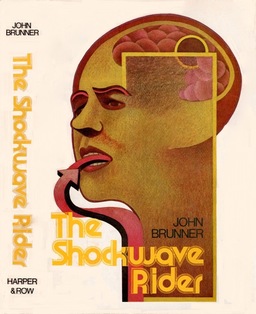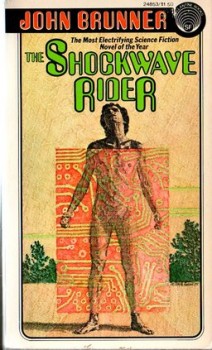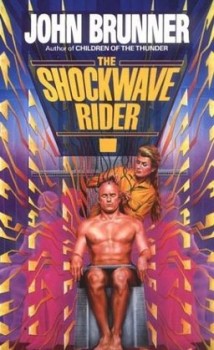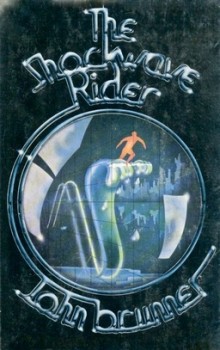Disasterville U.S.A. :The Shockwave Rider by John Brunner
If there is such a phenomenon as absolute evil, it consists in treating another human being as a thing.
Nick Halflinger in The Shockwave Rider
 Cyberpunk appeared as a description of a sub-genre in the early eighties. The word first appeared in print in 1983 as the title of a story by Bruce Bethke and it was quickly adopted to cover the works of near-future science fiction by William Gibson, Bruce Sterling, Pat Cadigan, and others. The general connection between books like Gibson’s Neuromancer (1984) and Neal Stephenson’s Snowcrash (1992) was the depiction of high technology mixed into a crumbling, corrupt society.
Cyberpunk appeared as a description of a sub-genre in the early eighties. The word first appeared in print in 1983 as the title of a story by Bruce Bethke and it was quickly adopted to cover the works of near-future science fiction by William Gibson, Bruce Sterling, Pat Cadigan, and others. The general connection between books like Gibson’s Neuromancer (1984) and Neal Stephenson’s Snowcrash (1992) was the depiction of high technology mixed into a crumbling, corrupt society.
Cyberpunk as a named thing might date to only 1983 or so, but as a movement in science fiction its roots are deeper. For years prior to the appearance of Neuromancer, usually thought of as the first cyberpunk novel, sci-fi authors had been writing about the dangerous effects — on society and individuals — of computers, communications, cybernetics, and related fields. In the UK, J.G.Ballard, and in the US, Philip K. Dick, laid a lot of the groundwork for the genre in books featuring rebels, man-machine interfaces, often lots of psychoactive drugs, and a general dystopian atmosphere. It’s little wonder that Dick’s 1968 novel, Do Androids Dream of Electric Sheep?, should become the basis for the film Blade Runner, easily one of the first cyberpunk movies.
English author John Brunner (discussed at great length here at Black Gate) started his writing career creating fairly standard space opera. In the mid-sixties he began writing stories in more contemporary settings, such as the 1965 novel, The Squares of the City. In it, a traffic engineer is hired to work in the newly-built capital of a South American nation (echoes of Brasilia). While there he becomes a piece, quite literally, in game of chess being played between two of the country’s power brokers.
This move to contemporary and near-future sci-fi culminated in the appearance of Stand on Zanzibar in 1968. Its portrayal of a wildly over-populated Earth, conveyed in the snapshot style of Dos Passos’ USA Trilogy, won Brunner the Hugo award for best novel. It also marks the start of what’s been called his Catastrophe Quartet.
Over the next seven years, Brunner wrote three more novels focusing on different contemporary issues he saw leading mankind down dark pathways. The next, Jagged Orbit (1968), was about using racism to market weapons. In The Sheep Look Up (1972), pollution was threatening to swamp humanity. Finally, in 1975, The Shockwave Rider appeared.
 Brunner was inspired by Alvin Toffler’s non-fiction Future Shock (1970), a book that saw people as suffering from mental dislocation and collapse in the face of rapid and overwhelming societal changes, coupled with a fearful conversation with writer and scientist Greg Benford about DARPA (which developed new technologies for weapons) and computer viruses. In The Shockwave Rider, set around the year 2020, Brunner created a world of instant connectivity without any sort of digital privacy, extreme social mobility, and, above all, a constant, damaging, barrage of information.
Brunner was inspired by Alvin Toffler’s non-fiction Future Shock (1970), a book that saw people as suffering from mental dislocation and collapse in the face of rapid and overwhelming societal changes, coupled with a fearful conversation with writer and scientist Greg Benford about DARPA (which developed new technologies for weapons) and computer viruses. In The Shockwave Rider, set around the year 2020, Brunner created a world of instant connectivity without any sort of digital privacy, extreme social mobility, and, above all, a constant, damaging, barrage of information.
The hero of Brunner’s book is Nick Halflinger, orphan, foster child, and government experiment. After being spotted by talent scouts as possessing an exceptionally quick intellect, Nick is placed in Tarnover, a super-secret government lab. The goal of the installation’s operators is to create a person capable of handling future shock, coursing out in front of it, impervious to its deleterious effects — and then weaponize that person. The world powers in the novel have carried out nuclear disarmament. Instead of an arms race, their militaries now focus on a “brain race.”
Nick wants nothing to do with Tarnover’s plans for him, seeing them as a betrayal of his talents. When asked why, he answers:
“My definition is the same as yours. The only difference is that I mean what I say, and you manipulate it. What a wise man can do, that can’t be done by someone who’s merely clever, is make a right judgment in an unprecedented situation. A wise man would never be overloaded by the plug in life-style. He’d never need to go get mended in a mental hospital. He’d adjust to shifts of fashion, the coming-and-going of fad-type phrases, the ultrasonic-blender confusion of twenty-first-century society, as a dolphin rides the bow wave of a ship, out ahead but always making in the right direction. And having a hell of a good time with it.”
The novel opens with Nicky in restraints, drugged and hooked up to all sorts of monitors. Six years earlier he fled Tarnover and began a life hiding out while traveling across the US, a land plagued by teenage Road Warrior-style gangs, refugee towns left over from the Great San Francisco Bay Quake a generation earlier, and the secured compounds of the megawealthy and hypercorporations. Returned to Tarnover, his captors hope to discover how he escaped detection for so long and turn that information to their advantage.
Like his interrogators, the reader learns of Nick’s time outside Tarnover as he is mentally regressed, pulling up his past. Chapters alternate between conversations between Nick and his prime questioner, Paul Freeman, and Nick’s escapades. Nick, perhaps the first hacker hero in sci-fi, covers his tracks and builds new identities by burrowing into the data net, and unleashing computer worms (a term credited as Brunner’s invention in this book) to destroy any traces of his existence. His training enables him to slip into new personalities when needed. The first time we meet Nick outside of Tarnover he’s an evangelical minister. Other personas included “Utopia designer, lifestyle counselor, Delphi gambler, computer-sabotage consultant, [and] systems rationalizer.”
While free, Nick is constantly trying to find ways to prevent his recapture. This leads him to deliberately befriending an executive with a major hypercorp in order to use its privileges to gain access to more secure information on the net. When he realizes he about to be exposed, he runs to the Paid Avoidance Zone. A huge swath of northern California has been allowed to remain off the grid — in exchange for making no demands on the federal or state governments.
 In the P.A. town of Precipice, Nick makes important discoveries that expose some of the darkest secrets at the heart of 21st century America and its rotting society. Studies made by scientists affiliated with Precipice of the aftermath of the Great Quake were published as Disasterville U.S.A.. The study made striking claims about America’s collapsing society and what forces might be deliberately orchestrating it. Those reports had since been suppressed and denounced as flawed. During his interrogation Nick is able to use much of what he learned to begin to turn the tables on his captors, and strike a blow against the powers lurking in the shadows.
In the P.A. town of Precipice, Nick makes important discoveries that expose some of the darkest secrets at the heart of 21st century America and its rotting society. Studies made by scientists affiliated with Precipice of the aftermath of the Great Quake were published as Disasterville U.S.A.. The study made striking claims about America’s collapsing society and what forces might be deliberately orchestrating it. Those reports had since been suppressed and denounced as flawed. During his interrogation Nick is able to use much of what he learned to begin to turn the tables on his captors, and strike a blow against the powers lurking in the shadows.
And that’s pretty much the plot. As a simple matter of plot and characters, The Shockwave Rider is a shaggy mess. Aside from Nick and Freeman, few of the characters are much more than a collection of minor traits or simple archetypes. There’s the coldhearted government operative, the incalculably wise small town politician, the girl who helps the hero see the truths hidden in his own heart, etc.
The end, impossibly happy and upbeat considering the bleak scenario exposed in the book’s last section, is rushed and a little unclear. It’s never really exciting, even with the sudden threat of nuclear annihilation. Half the book is made up of conversations between Nick and Freeman. Nick’s restrained in a chair while Freeman’s sitting on another. These are not the things great books are usually made of. And yet The Shockwave Rider remains a compelling book with concerns even more pressing today than when it first appeared over forty years ago.
Brunner’s arguments as voiced by Nick, and Freeman’s counterarguments, are laid out with force and vigor. Most of the action in the book, and it is action, even if of a mental kind, comes during their sharp interplay. They thrust and parry, attempting to wear each other down, each desirous of winning the other to his side.
Many of Brunner’s fears are my own. Constant interconnectivity is sold as a total good, but it’s burdensome, wearing. There’s the ubiquity of information about individuals and the complete lack of privacy around it. Every keystroke, every word is recorded. All electronic conversations are listened in on by government computers. Corporations micro-tailor their ads by buying and collecting every bit of data about their customers with the intention of modifying their behavior. People live under a microscope that’s never lifted and every action is scrutinized endlessly.
News media exist to show people the worst things in the world, simultaneously making them feel better about their own circumstances and making them believe the world is fundamentally dangerous and unstable. They don’t look for solutions or to expose the true nature of government and corporate corruption. The idea that the media operate in conjunction with the powers that be to keep citizens off-kilter and constantly unsettled strikes a chord. These and several other elements brought up in the book resonate today.
 When Brunner wrote The Shockwave Rider, the digital age was still two decades away. As a prognosticator, he fumbled in his predictions about how we would be connected. There’s no equivalent to WiFi, and phones need to be jacked into desktop-style computers to connect to the net. In several other technical aspects he gets things wrong as well, but with the big things he succeeds.
When Brunner wrote The Shockwave Rider, the digital age was still two decades away. As a prognosticator, he fumbled in his predictions about how we would be connected. There’s no equivalent to WiFi, and phones need to be jacked into desktop-style computers to connect to the net. In several other technical aspects he gets things wrong as well, but with the big things he succeeds.
Like Toffler, Brunner feared changes to society were coming too rapidly and with too much potential for harm. Governments were going to utilize the dislocation caused by change to its own advantages. Collusion between politicians and businesses was going to get worse. The results of these things would be a balkanized population, encouraged to be restless and unsettled, and thereby more readily controllable. The systems that allow the constant flow of information is useful for individuals, but its real power is in how it multiplies corporate and government strength. Many of the things he was scared of have happened, and for the basic reasons he predicted: complete connectedness and information overload.
Brunner’s solutions to some of these things reek a little too much of the hippie-era — the big answer to society’s ills seems to be outlawing poverty and creating low-density green towns with town meeting-style direct democracy. Nonetheless, he was really trying to understand where the world was and where the coming new age would take it. One of the most important aspects of sci-fi is its ability to speculate about what’s happening right now and right around the corner, something Brunner took to heart.
The most successful sci-fi aspect of The Shockwave Rider is the post-earthquake America Brunner created. So many of the basic tropes of cyberpunk feature in those pages. While the average American is locked in a cycle of scarcity and under constant surveillance, giant corporations rake in ever-increasing profits while their executives live in splendid high-rise towers. Tremendous scientific advances (sapient dogs, near-space travel and asteroid mining, bio-engineered super babies, etc.) exist along with roving gangs and commercially-televised gladiatorial games.
And then there’s the hacker hero. Brunner understood that information, not simply force, would be the power in the dawning age. Nick’s abilities to manipulate and control data, not to shoot a gun or pilot a space fighter, are what make him capable of fending off the powers aligned against him. Case, Gibson’s hacker from Neuromancer, and the various keyboard cowboys of Bruce Sterling and W. T. Quick, to name two cyberpunk exemplars, lay in the shadow of Nick Halflinger.
I was really surprised how much I enjoyed The Shockwaver Rider. I loved it to death when I read it thirty years ago during the first blush of the cyberpunk movement. I had come across it reading reviews of Gibson and Sterling, and was really caught up with its mix of high-tech paranoia and righteous rebelliousness. While much less prone to dorm-room conspiracy theorizing than I was then, I found Brunner’s fears and arguments still worked their spell on me. The age he feared has come to pass, and it is changing deeply, if not always for the worse, the fundamentals of society. This book, once a look at a generation ahead, now seems like one only written yesterday.
NOTE: I haven’t read Jagged Orbit so I have nothing to say about it, save the few reviews I’ve seen are negative. I read and loved Stand on Zanzibar thirty years ago and I’m very curious how it holds up today. The Sheep Look Up had its goofy moments, but even thirty years ago it seemed hopelessly dated and burdened by the uber-Abbie Hoffman clone, Chad Mulligan.
Fletcher Vredenburgh reviews here at Black Gate most Tuesday mornings and at his own site, Stuff I Like when his muse hits him. Right now, he’s writing about nothing in particular.
Nice article!
Love John Brunner’s works
Just wanted to note this; Shoddy journalism (not you but mass media stuff) sometimes credits this as the “First” Cyberpunk novel in that it predicted the internet… While when Brunner wrote this the internet was beginning – college and government computer linking – so it was bold but not wild to imagine something approaching today’s internet.
The “Internet” goes all the way back to H.G.Wells who described it when it was incocievable at the time. In his book “When the Sleeper Wakes” there was NETFLIX… A way of illustrating the technology of the time was to extrapolate that if an image could be captured (photograph) and transmitted, (Camera Obscura) – perhaps with technology it would be possible to do that with scenes – say an entire play – and store it for ready playback and long transmission. In short “Every play performed in the last century” was available – and there was issues with actors wanting royalties for the lowering demand of live performance, etc.
This was also repeated in a lesser form in Nowlan’s “Armageddon 2419 AD” and “Airlords of the Han” – the original “Buck Rogers” stories.
The problem is – well imagine a high tech future you write about – do you write about Captain Tomorrow going to the jungles of venus in his Asbestos lined air-conditioned space suit to zap the jungle dwellers and tech them their planet was bought for that box of beads fair and square and they use the back door in human establishments…
-or-
two pimply faced teenagers on a furry muck at 4 am…
Describing “The internet” to a pre-high tech lifestyle public had to be laconic at best. Later when the reading public started to be concerned/excited about the technological changes, no problem.
BTW – there’s a Day of Action for Net Neutrality on the 12th…
Going to post the protest icons?
Or, perhaps, confident TOR will make sure the site is not blocked and pay the cable companies to block that pesky Vox Day and anyone else with an “Independant Author” self-publishing flair from being seen on the net?
@greengestalt – Thank you. Yeah, the internet claim is right out. I think Brunner only a vague idea of what the net and its enabling tech would look like, but he got right the effects it could have on people and a society.
Thank you for pointing me toward the Wells and Nowlan. I know I’ve at least got the Wells kicking around somewhere.